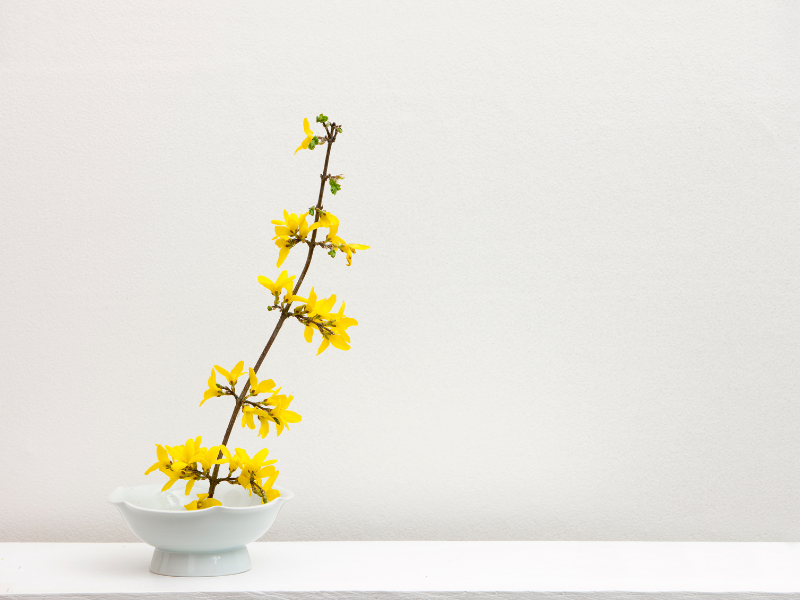
Introduction to Ikebana
Ikebana, also known as Kado, is the Japanese art of flower arrangement. It is a disciplined and contemplative practice that goes beyond simple floral decoration. Ikebana emphasizes the harmony between nature and human existence, incorporating principles of balance, minimalism, and symbolism. This art form has a rich history and cultural significance in Japan, dating back to the 6th century.
Understanding the Ikebana Method
Ikebana follows a distinct method that sets it apart from other styles of flower arranging. Unlike conventional floral arrangements, Ikebana focuses on creating a sense of space, balance, and harmony. It involves the thoughtful placement of flowers, branches, and other natural elements in a minimalist and asymmetric composition. The arrangement aims to capture the essence and beauty of nature while expressing the artist’s emotions and artistic vision.
Unveiling the Meaning of Ikebana
The term “Ikebana” itself carries meaning. “Ike” translates to “life” or “alive,” while “bana” means “flower.” This reflects the central philosophy of Ikebana, which seeks to infuse life and vitality into floral arrangements. Each element in an Ikebana arrangement is carefully chosen to convey specific messages and evoke emotions. From the choice of flowers to the selection of containers and the placement of branches, every aspect has symbolic significance.
Tools and Materials Used in Ikebana
Ikebana practitioners utilize specific tools and materials to bring their artistic vision to life. Some commonly used tools include:
- Kenzan: Also known as a “flower frog,” this metal or plastic base with spikes holds the flowers securely in place.
- Hasami: Traditional Ikebana scissors used for precise cutting and shaping of branches and stems.
- Suiban: Shallow ceramic or metal containers that serve as a foundation for the arrangement.
- Kakei: Hanging vases or containers that are suspended from a wall or ceiling, adding a unique dimension to the arrangement.
As for materials, Ikebana incorporates a wide range of plant elements, including flowers, branches, leaves, grasses, and even fruits. The choice of materials depends on the season, occasion, and the intended message of the arrangement.
Duration and Lifespan of Ikebana Arrangements
Unlike traditional floral arrangements that are often short-lived, Ikebana arrangements can have an extended lifespan. The duration depends on various factors, such as the type of materials used, their condition, and the environment in which the arrangement is placed. With proper care and maintenance, an Ikebana arrangement can last anywhere from a few days to several weeks. Regular watering, trimming of stems, and changing the water can help prolong the life of the flowers and maintain the beauty of the arrangement.
Examples and Practical Applications of Ikebana
Ikebana finds its applications in various settings, including homes, temples, exhibitions, and special ceremonies. Here are some examples of how Ikebana is utilized:
- Home Decor: Ikebana arrangements bring a touch of elegance and tranquility to residential spaces. They can be placed as a centerpiece on a dining table, displayed in a hallway, or positioned in a tokonoma (alcove) to create a focal point in a traditional Japanese room.
- Cultural Events: Ikebana is often showcased during cultural events and exhibitions, where artists demonstrate their skills and present breathtaking arrangements. Visitors can appreciate the artistic expression and learn about the different styles and techniques of Ikebana.
- Weddings and Ceremonies: Ikebana arrangements can be incorporated into wedding ceremonies, tea ceremonies, and other traditional celebrations. They add a sense of grace and symbolism, enhancing the overall atmosphere and creating a memorable experience for participants.
Tips for Exploring Ikebana
For those interested in learning Ikebana, here are some practical tips to get started:
- Find a Qualified Instructor: Seek out a certified Ikebana instructor who can guide you through the fundamentals and techniques of Ikebana. They will provide valuable insights, critique your work, and help you develop your skills.
- Embrace Minimalism: Emphasize simplicity and space in your arrangements. Let the materials speak for themselves and strive for a sense of balance and harmony.
- Study Ikebana Styles: Familiarize yourself with the various Ikebana schools and styles, such as Ikenobo, Sogetsu, and Ohara. Each has its unique characteristics and principles that you can explore and incorporate into your own arrangements.
- Observe Nature: Take time to observe and appreciate the natural world. Study the shapes, colors, and textures of different plants, and understand how they can be incorporated into your Ikebana arrangements.
- Practice Mindfulness: Ikebana is not only about the final arrangement but also the process. Approach each arrangement with a mindful and meditative mindset, allowing yourself to be fully present in the creative process.
Conclusion
Ikebana is a captivating art form that combines nature, creativity, and symbolism. Through careful selection, placement, and mindful arrangement of flowers and plant materials, Ikebana practitioners create captivating compositions that evoke emotions and convey messages. By understanding the fundamental concepts, exploring different styles, and seeking guidance from experienced instructors, anyone can embark on a rewarding journey in the world of Ikebana. Let this ancient Japanese art form inspire you to create beauty, harmony, and tranquility with each arrangement you create.